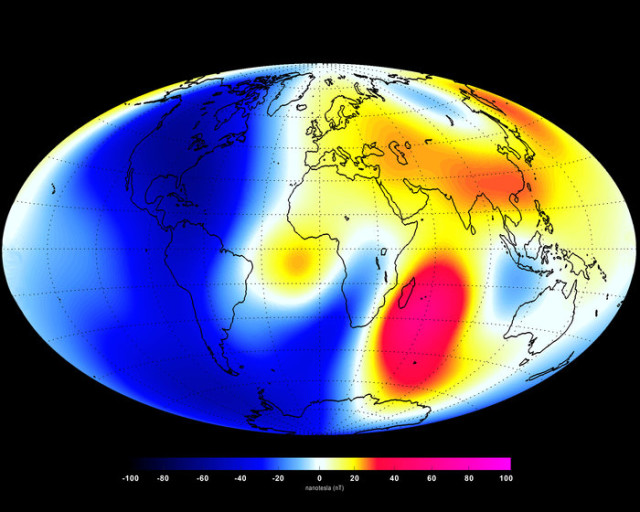
Changes in Earth’s magnetic field from January to June 2014 as measured by the Swarm constellation of satellites. Red represent areas of strengthening, blues show areas of weakening. ((C) ESA/DTU Space)
Earth’s magnetic field is weakening, according to measurements taken over the past six months by the European Space Agency’s (ESA) Swarm satellite constellation.
The measurements–taken between January and June 2014–come from the first high-resolution results made by Swarm, and also indicate that the magnetic field has declined most dramatically in the Western Hemisphere while increasing in other areas, such as the southern Indian Ocean.
The measurements also confirm that Earth’s magnetic north continues its slide towards Siberia.
Scientists say the shifting of the magnetic north pole is part of a process that takes thousands of years and will eventually result in the swap in magnetic poles – north will be south and vice-versa.

A schematic illustrating the relationship between motion of conducting fluid, organized into rolls by the Coriolis force, and the magnetic field the motion generates. (USGS)
Scientists studying ancient rocks that came to the surface from deep within our planet have found that the Earth’s north and south magnetic poles have swapped with each other several hundred times during the past 160 million years.
Past research, including a study released in 2011, suggests that shifting of the Earth’s tectonic plates may play a role in the shifting of the magnetic poles.
The 2011 study suggested that, as the tectonics plates shift and move, they push into Earth’s crust at subduction zones, and could continue until they reach the outer core, modifying the flow of its molten iron which helps generate the magnetic field.
The Earth’s magnetic field protects us from harmful radiation from cosmic rays as well as high-energy particles from the sun. It has previously been shown to have faded by about 10 percent since measurements were first made in 1835 by German mathematician Carl Friedrich Gauss.
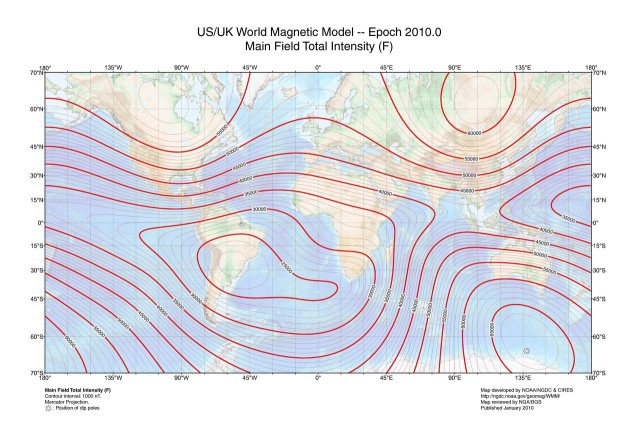
This is a world map of main field total intensity created by the National Geophysical Data Center at NOAA.
But unlike what was portrayed in the 2003 Sci-Fi movie, “The Core”, the Earth’s magnetic field will not simply fade out.
Field strength changes in the magnetic field are considered normal and while measurements, including those made by Swarm, indicate that it’s fading a bit, scientists say the magnetic field could just as easily regain its strength and become strong again.
The findings made by the Swarm mission were presented on Thursday, June 19, 2014, at the Third Swarm Science Meeting in Copenhagen, Denmark.
The ESA Swarm mission, which measures the magnetic signals that come from Earth’s core up through the ionosphere and magnetosphere, was launched in November 2013.
Three identical but separate spacecraft are operating in tandem with each other for the mission.
All three units are circling the Earth in a polar orbit. Two of the three spacecraft, Swarm A and B, orbit at an altitude of about 460 km, while the third spacecraft Swarm C orbits at a higher altitude of about 530 km.
Mission officials say that as the Swarm program progresses, it will provide an unparalleled understanding of complex workings of Earth’s magnetic field.
Swarm mission officials said that as the spacecraft continues to send data, scientists hope to uncover the influence of the Earth’s mantle, crust, oceans, ionosphere and magnetosphere in creating and maintaining our planet’s protective magnetic shield.

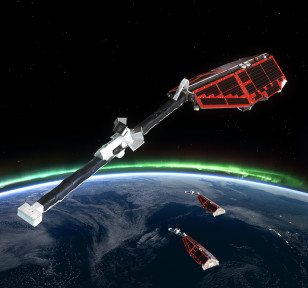








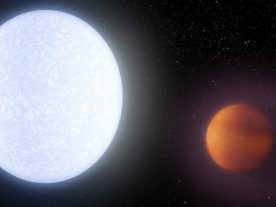
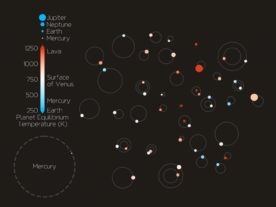







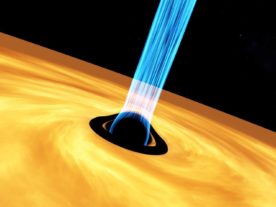


Comments are closed.